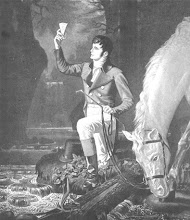My host for the visit was Gary Leveille, vice president of the Historical Society. He and local historian Bernard Drew have been working away at organizing and cataloging the Rising archives, which are contained in 20 boxes. As much as I wanted to ruffle through each and every box of payroll records, paper samples, photographs and marketing materials dating from 1899, I had to hold myself in check until a later date.
And that's just as well, because Gary was kind enough to show me the most treasured part of the collection - a painting of the Rising Paper Mill complex by Yvonne Twining Humber. It is a magnificent painting and is far superior and much more interesting than any photo I could have taken to present to you today.
Here is a link to an article about her very distinguished career.
The Rising mill today is owned and operated by the Hazen Paper Company of Holyoke, Mass., which specializes in film and foil laminations, gravure printing, specialty coating, and rotary embossings. Hazen products enjoy wide acceptance for use in luxury packaging, bookbinding, lottery and other security tickets, tags and labels as well as for photo and fine art mounting.
We'll have an opportunity to dive deeper into the history of the Rising Paper Mill and the hamlet of Housatonic at a later date. Next up: Dard Hunter and the Lime Rock Mill.




